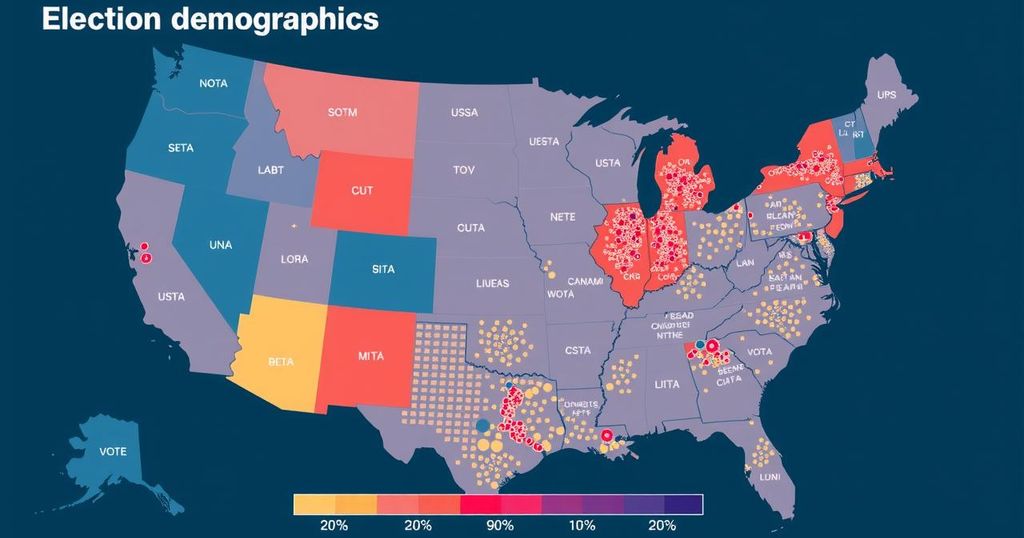Gender Dynamics in the US Elections: The Shifting Support for Trump Among Voters
Donald Trump currently enjoys significant support among male voters, especially young men, while facing declining support from women, particularly white women, due to his controversial remarks and issues surrounding reproductive rights. The divergence in political alignment between genders is becoming increasingly pronounced as Trump capitalizes on themes of masculinity and anti-establishment rhetoric, juxtaposed with women’s mobilization around rights issues.
A recent New York Times poll indicates that Donald Trump holds a significant lead over Kamala Harris among male voters, with an 11-point advantage. This trend highlights Trump’s solid base of support which is primarily constituted by white men, yet it also extends to substantial segments of Hispanic-American and African-American men. Remarkably, despite Trump’s contentious remarks towards Hispanics and his use of anti-immigrant language, approximately half of Hispanic men perceive him as sufficiently strong to lead the country. Furthermore, approximately 25% of African American men under 50 years report their intention to vote for Trump, a statistic that remains unaffected by his past comments supporting white supremacist groups. The disproportionate support for Trump among young men in particular points to a broader ideological shift, with many men gravitating towards conservative views and the Republican party more than in previous generations. The aforementioned New York Times poll reveals that Trump commands 58% of the young male vote, as opposed to Harris’s 37%. This demographic shift indicates a growing divergence between the political alignments of young men and women, where young men increasingly identify with conservative ideologies while young women skew towards progressivism. Analyzing the motivations behind young men’s support for Trump, it appears they are attracted to his rejection of what they perceive as societal pressures to conform to traditional male roles. Research shows that a notable portion of men feel undervalued in contemporary society, with many expressing frustration regarding social standards of masculinity. Additionally, Trump’s brash rhetoric and unconventional persona resonate with men seeking a figure who embodies traditionally masculine traits. His tactics may serve as a counter-narrative to the rising influence of women, with many male supporters feeling their status threatened by gender equality movements. According to a Pew Research study, approximately one-third of Trump supporters believe that women’s advancements have occurred at men’s expense. Conversely, the landscape for female support has dimmed significantly for Trump, particularly among white women, who previously formed a critical aspect of his voter base. Many women have reacted strongly against Trump’s and his affiliates’ misogynistic rhetoric, especially in light of the Supreme Court’s recent decisions regarding reproductive rights. While both men and women largely support reproductive rights, the issue resonates more acutely with women, prompting many to reassess their support for Trump. Recent polls indicate that Trump’s lead among white women has dwindled from a margin of seven points in the 2020 elections to a mere one point in 2024. The distinct communication styles of both candidates have further exacerbated the gender gap observed in this election cycle, leaving it uncertain who will ultimately prevail.
The United States is entering a crucial election cycle, and shifts in voter demographics and preferences are increasingly significant. Recent trends show that male voters are gravitating towards Donald Trump, with a specific focus on younger men who previously leaned towards progressive candidates. In contrast, support from women for Trump is waning, particularly among white women, who once significantly contributed to his electoral success. The interplay of societal norms, gender roles, and political identity has created a complex and dynamic landscape that underscores the pivotal role of gender in this electoral cycle.
In summary, the political landscape approaching the 2024 elections highlights a notable divide between male and female voters, with Trump gaining substantial traction among men, particularly young males, while women, especially white women, exhibit declining support for him. His strong appeal lies in a rejection of conventional societal expectations of masculinity and a resonating fear of shifting gender dynamics. Meanwhile, women are mobilized by issues central to their rights and representation, suggesting that the 2024 elections will be heavily influenced by gender-related themes and voter sentiments.
Original Source: theconversation.com




Post Comment